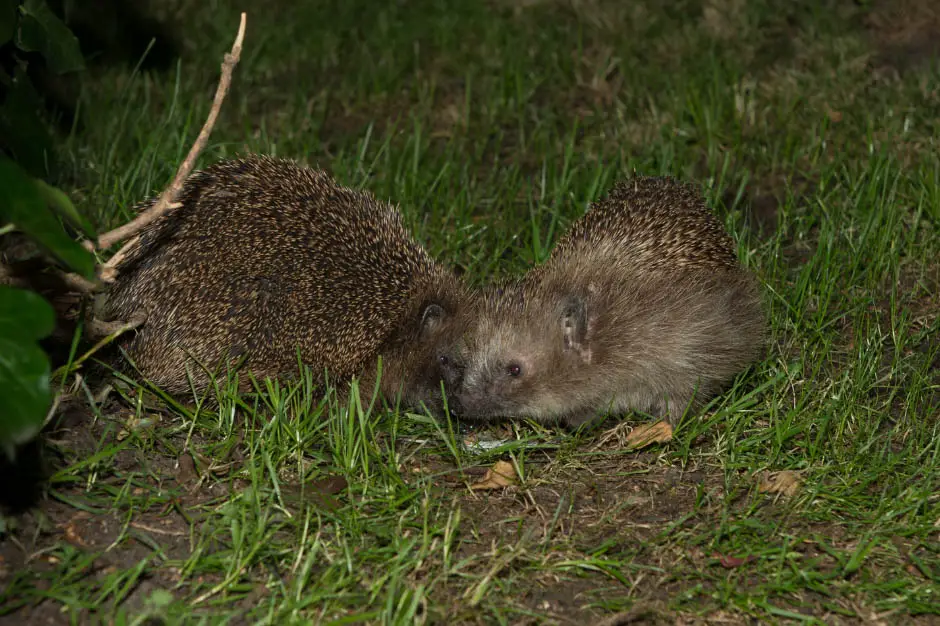All animals mate in one form or another, although there are some animals that can reproduce alone, a vast majority must mate with another of their species to reproduce.
When we consider that hedgehogs must mate to produce baby hedgehogs, it conjures up some painful imagery.
With their spines and soft bellies, we cannot help but wonder how the male doesn’t go back to his burrow with holes in his belly.

However, hedgehogs have their mating rituals sussed out, they know what they’re doing, and it is not all that different to the way in which many species do it.
Although, no hedgehog is taking his mate out on a date to a five-star restaurant for some sautéed slugs with a beetle relish. When it comes to the animal kingdom, hedgehogs are no different, and they mate much like many others do.
That being said, they differ from animals like albatross, wolves, elephants, and penguins, all of whom stick together after mating, albatross even mate for life. Hedgehogs make it quick and simple.
Let’s have a look at what exactly goes into hedgehog mating.
Courtship
When it comes to courtship, hedgehogs are more on par with ducks than anything else.
Ducks are known to be rather aggressive in courtship, with the males basically chasing the female around until she gives up and accepts her fate. Hedgehogs are not all that different.
When a male hedgehog is courting a female, it can be relentless and sometimes aggressive.
In typical circumstances, the male will slowly circle the female persistently, changing direction every now and again, then making attempts to get behind her so that he can mount her.
As he does this, she will always face him. If a lady is not all that impressed with the male and doesn’t like her prospective mate, then it is not uncommon for a female to aggressively bite and sometimes headbutt a male.
Sometimes this headbutting can be with such force that the male can be taken off his feet.
Some males will try to counter this by lowering his forehead spines, or tilting on one side to expose his spines and shield himself in case the female does decide to attack him.
In hedgehog courtship, multiple males may also fight over a single female, she will often walk off while they are fighting over her. Who has the time for that? Certainly not female hedgehogs.
Hedgehogs are also polygynous, which means that they will each mate with multiple partners. However, courtship does not always lead to sex and babies, in fact 93% of courtships fail.
Courtship may fail as the result of a male just giving up and losing interest, the female walking away, or in some cases the determination to avoid possible inbreeding. Females may also test out several suitors and will choose the male they like the most to breed with.
How?
So, how do they go about the actual act of breeding without one of them getting stabbed by the other?
Well, the actual process is quite a delicate operation. The female will adopt a special position in which her spines are flattened, so the male will mount her from behind.
As the lady flattens her spines, this means the male won’t get stabbed by them and can proceed to mate with the lady as delicately as possible to produce young hoglets.

One curious thing about hedgehog mating is the male anatomy. Hedgehogs are omnivores, with being insectivores taking up a large part of their diet, especially since they love eating beetles.
Most insectivores will have something called a baculum which is a bone in the males’ genitalia. However, hedgehogs do not have this, instead they have muscle tissue that allows them to maintain their erection in order to mate successfully with a female.
Scientists working with hedgehogs find this fascinating, and rather unique, and this trait seems to be a constant in hedgehogs regardless of where in the world they live.
When?
Hedgehogs will be ready to breed in the middle of spring, in the Northern Hemisphere this means April time. They will typically make snuffling and grunting noises at night in gardens and hedges.
The male will circle the female, sometimes for hours, in an attempt to get her to accept him.
Once they have mated, the male will take his leave and take no part in the rearing of their young. He just mates her, does his job, and heads home to eat some slugs and beetles while she prepares for her hoglets.
Once the male has left, the female will start to make a special maternity nest made of leaves, grass, and other things she finds. She will be pregnant for around a month, or 32 days, and then she will give birth.
A female can have between 1 and 11 babies, although the most common number of hoglets a female will give birth is 5.
Hoglets
Hedgehogs will typically start to give birth in the summer months, depending on when they mated. Their litter size averages at 5 babies, but sadly they will typically only wean one or two of these babies successfully.
Female hedgehogs are likely to desert or even eat her hoglets if she is disturbed, although, not always. She may carry them to a new location in her mouth.
After a month or so, her babies will start to leave the nest with her as she goes hunting for food, so that they can also learn the art of living as a lone hedgehog in the wide open world.
Then within a few weeks of beginning this, they will have learned all her tricks and will now wander off on their own.
They leave the nest and begin their lives as independent hedgehogs, leaving mom to rest peacefully and get back to her life as a single lady.
It is possible that a female may mate twice in one year, however hoglets born in the fall are less likely to survive the harsh winters and hibernation so young.









